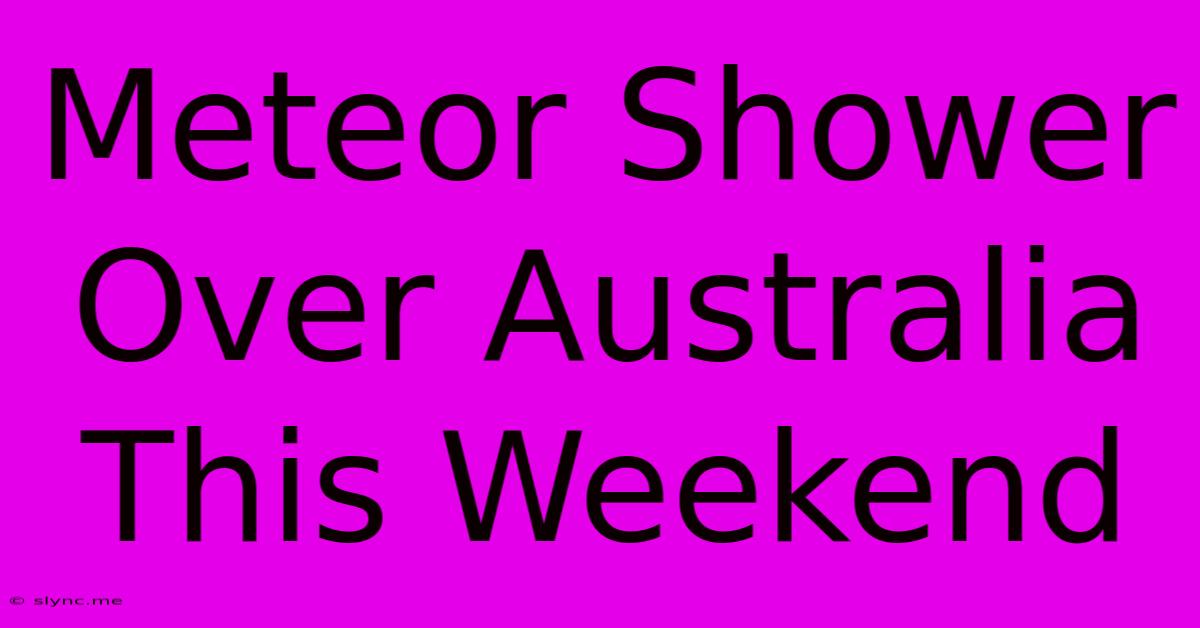Meteor Shower Over Australia This Weekend

Discover more detailed and exciting information on our website. Click the link below to start your adventure: Visit Best Website Mrs.Amykhan. Don't miss out!
Table of Contents
Meteor Shower Over Australia This Weekend: Don't Miss the Lyrids!
Are you ready for a celestial spectacle? This weekend, Australia is in for a treat as the Lyrid meteor shower graces our night skies. Prepare for a breathtaking display of shooting stars, making it a perfect opportunity for stargazing and capturing stunning astrophotography.
When and Where to See the Lyrid Meteor Shower
The Lyrid meteor shower peaks on Saturday night, April 22nd, and into the early hours of Sunday, April 23rd. However, you'll likely see some meteors in the nights leading up to and following the peak. The best time to view the shower will be after midnight, when the radiant point (the point in the sky from which the meteors appear to originate) is highest in the sky.
The Lyrids radiate from the constellation Lyra, near the bright star Vega. While you don't need to know exactly where Lyra is to enjoy the shower, you'll get the best view by finding a dark location with a clear view of the eastern and northern horizon. Light pollution from cities significantly reduces visibility, so heading to a rural area is highly recommended.
Tips for Optimal Meteor Shower Viewing
To maximize your chances of witnessing this celestial event, keep these tips in mind:
- Find a dark location: Escape city lights! The darker the sky, the more meteors you'll see. National parks or remote areas are ideal.
- Be patient: It takes time for your eyes to adjust to the darkness. Allow at least 20-30 minutes for your vision to fully adapt.
- Bring a blanket or chair: You'll likely be lying down or sitting for an extended period, so comfort is key.
- Check the weather forecast: Clear skies are essential for meteor shower viewing.
- Avoid looking at your phone: The bright light from your phone will ruin your night vision.
- Bring a friend or family member: Sharing the experience enhances the enjoyment.
What to Expect from the Lyrid Meteor Shower
The Lyrids aren't known for producing incredibly high meteor counts like some other showers (like the Geminids), but they are known for producing bright, fast meteors. You can expect to see anywhere from 10 to 20 meteors per hour under ideal conditions. Some years even deliver surprising bursts of activity!
The Lyrids are also known for their fireballs – exceptionally bright meteors that leave persistent trails across the sky. These fiery streaks are a truly unforgettable sight.
Capture the Magic with Astrophotography
If you're an aspiring astrophotographer, the Lyrid meteor shower provides a fantastic opportunity to hone your skills. Remember to use a wide-angle lens and a long exposure time to capture the meteors streaking across the night sky. A tripod is essential for keeping your camera steady.
Don't Miss Out!
The Lyrid meteor shower is a stunning celestial event that shouldn't be missed. So, gather your friends and family, find a dark spot, and prepare to be amazed by the beauty of the night sky over Australia this weekend! Share your photos with us using #LyridMeteorShowerAustralia – we’d love to see your incredible captures!
Further Reading and Resources
For more detailed information about the Lyrid meteor shower, including precise radiant coordinates and predicted peak times, check resources like the websites of [mention reputable astronomy organizations relevant to Australia].
This weekend offers a chance to connect with the cosmos, so make the most of it! Clear skies and happy stargazing!

Thank you for visiting our website wich cover about Meteor Shower Over Australia This Weekend. We hope the information provided has been useful to you. Feel free to contact us if you have any questions or need further assistance. See you next time and dont miss to bookmark.
Also read the following articles
| Article Title | Date |
|---|---|
| Milan 2 1 Tsrvena Zvezda Video Goliv Ta Oglyad | Dec 13, 2024 |
| Molan Reacts To Sky 2 Day Fm Job Loss | Dec 13, 2024 |
| Peremoga Panatinayikosa Liga Konferentsiy | Dec 13, 2024 |
| Khto Takiy Shatskiy Zagadka Kontsov | Dec 13, 2024 |
| Radio Host Molan Addresses Abrupt Dismissal | Dec 13, 2024 |
